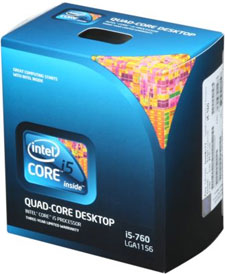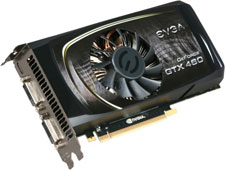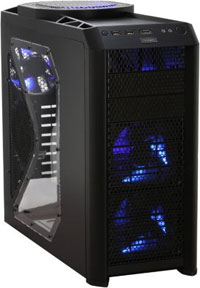Holiday 2010 System Builder's Guide
by AnandTech Staff, edited by Jarred Walton on November 19, 2010 2:00 AM EST- Posted in
- Guides
- Systems
- Holiday 2010
| Vivek's Midrange Intel System | ||
| Hardware | Component | Price |
| Processor |
Intel Core i5-760 Lynnfield 45nm (4x2.8GHz to 3.33GHz Turbo, 8MB L3, 95W) |
$200 |
| Motherboard | Gigabyte GA-P55-USB3 (Intel P55) | $120 |
| Video | EVGA GTX 460 768MB (768-P3-1360-TR) ($30 MIR) | $140 |
| Alternate GPU | ASUS GTX 460 768MB (ENGTX460 TOP)($20 MIR) | ($150) |
| Alternate GPU | ASUS Radeon HD 6850 1GB (EAH6850) | ($200) |
| Memory |
Corsair XMS3 2x2GB DDR3-1600 CL9 (CMX4GX3M2A1600C9) |
$65 |
| Hard Drive | WD Caviar Blue 1TB (WD10EALS) | $70 |
| Optical Drive | ASUS 24x DVDRW (DRW-24B1ST) | $20 |
| Power Supply | OCZ ModXStream Pro 700W (OCZ700MXSP) ($25 MIR) | $55 |
| Case | Antec Nine Hundred Two | $89 |
| Total System Price (Price based on GPU choice) | $759-$819 | |
When Jarred pitched his idea of a midrange gamer build, I liked the general idea except for one thing—the AMD processor. I'm more of an Intel guy at heart, so I tried to envision a similar midrange system built around an Intel platform. I built a very parallel system for personal use around this time last year, so I'll toss in a few anecdotes from my experience.

The processor was by far the easiest choice to make. At the price point we're looking at, the Core i5-760 makes the most sense. It's a quad-core Lynnfield running at 2.8GHz, with the only difference between it and the $280, 2.93GHz i7-860 being the clock speed bump and the lack of Hyper-Threading in the i5. Given that you've got four cores to work with, you won't miss the extra threading capabilities unless you're running some really highly threaded workloads. The 2.66GHz i5-750 is still kicking around at $199 (I can't believe that Intel has kept it at exactly the same price it was a year ago when I bought one!), but you can find the 760 for the same price. I figure it's not worth the $80 bump to the i7 line, as that money is better spent elsewhere.
For the motherboard, I went with the Gigabyte GA-P55-USB3. It's a rock solid board with USB 3.0 and a second PCI-E slot for CrossFireX support. In a mid-priced motherboard, there's not too much else you can ask for (except for maybe IEEE 1394). The Gigabyte P55 line has been popular since the launch of Lynnfield, and based on my experience I have no problems recommending it. As with Jarred's build, if you're serious about CrossFire you'll probably want to go with a different board that can do x8/x8 to the GPUs; as luck would have it, Biostar's T5 XE CFX-SLI has dual x8 slots and tosses in SLI support (via a PLX chip), and depending on the vendor it's even cheaper than the Gigabyte offering. Is it as reliable and does it have great support should something go wrong? We haven't had any serious issues with Biostar, but they can be a bit hit-or-miss.
RAM is kind of dependant on how much you need—I went with 4GB in my build last year and haven't felt short of memory, but I'm adding more this Black Friday just in case. For this build, I went with a Corsair XMS3 4GB (2x2GB) kit of DDR3-1600. Corsair's XMS3 was one of the more reasonably priced RAM kits on Newegg, but you can really go for whatever you feel comfortable with. I know a lot of people who like the G-Skill Ripjaws line, but they're rather pricey especially if you go for the 7-8-7-24 timings ($88 versus $75 for the 9-9-9-24 Ripjaws, and $65 for the XMS3s that also run at 9-9-9-24). Unless you have a specific preference for brand, you're probably better off going for whoever has the best sale.
Hard drives are another place where once you determine the capacity and speed, you're not going to get a whole lot of performance variation between different brands. I know people that swear by Seagate, I know some that swear by Western Digital, I know a lot that swear they hate either (or both), and there's Anand, who swears against hard drives on principle. In all honesty, I don't care either way, so I specced this system with the WD Caviar Blue 1TB 7200RPM drive, which at $69 is not a bad buy. There are 1TB drives from Seagate, Samsung, and Hitachi at the same price, so you're not at a loss for choice.

The graphics card is where things get interesting. If you're a serious gamer, I figure the lowest you want to go is the NVIDIA GTX 460 768MB. Most of those are going for $169, but the bog-standard EVGA GTX 460 listed above has a $30 rebate on top of that, and the more customized (and mildly factory-overclocked) ASUS ENGTX 460 comes with a $20 MIR. So if you don't mind the MIR, you can get away with a "low-end" GTX 460 for $140-150. Given the overclocking potential inherent to the GTX 460, that's a pretty good price.
But what if you want something faster? The best place to look is the HD 6850 (the 6870, at $240-300, is a bit too expensive for a midrange build). Ryan really liked the ASUS EAH6850 when he looked at the XFX, MSI, and ASUS retail HD 6850 cards earlier this month, and so it makes another appearance here. At $200, it's competitively priced against the rest of the HD 6850 partner cards, and it makes a good tradeoff between temperatures and noise. Like the ASUS ENGTX 460, it comes with a token overclock and ASUS' highly effective Direct CU cooler. It's faster than the comparably priced 1GB GTX 460 cards, so it's a worthwhile upgrade to make if you'll make use of the extra graphics horsepower on hand.
Of course, now you have to decide if you're at all interested in adding a second GPU in the future; if so, you should note that most budget P55 boards only support CrossFireX. For those going the AMD route, the specced Gigabyte board will be fine, but if you're after SLI support, the Biostar T5 XE CFX-SLI has what you need for $15 more than the GA-P55, with an epic, highlighter-esque colour scheme thrown in just for kicks.
For the power supply, I went with the OCZ ModXStream 700W. This is what I ended up buying for my build last year, and I’ve had no problems with it. There's usually a good sale on it somewhere; I picked it up for $49 last year (after a $35 rebate) and it’s currently going for $55 after a $25 rebate. I know that the Corsair line of PSUs is very popular, but they’re significantly pricier than the OCZ, as are the Antec PSUs (unless you get a combo deal on one with a case like in Jarred’s build). Generally speaking, most of the 80 Plus certified PSUs will work well; some are still better than others, but the difference between 82% and 87% efficiency isn't all that great and the price often climbs rapidly once you move beyond the Bronze level. The OCZ is a standard 80 Plus model at a good price, but if you're looking for other options the Seasonic S12II 520W is Bronze certified, well reviewed, and costs just $10 more than the OCZ.

Case choices are very personal; I prefer flowing and elegant cases, like the old Cooler Master WaveMaster and the Thermaltake Tsunami, which is what I got for my own system. I abhor the design of the wildly popular Antec Nine Hundred—something about the weirdly pentagonal side just doesn’t sit right with me, though I must admit that it is a very high quality case. The Nine Hundred Two on the other hand has a more rectangular design that suits my taste much better, but at $90 it’s not the cheapest case on the block. Jarred specced his build with the Antec Three Hundred, which is a bit smaller and a bit cheaper, but get what you like.
So how does this stack up against Jarred's build? It has a more expensive case, PSU, motherboard, and processor with a slightly slower GPU (assuming you get the standard GTX 460 768MB), but then the i5-760 will generally outperform Phenom II 965. As configured and with the mail-in rebate for the GTX 460 and PSU, the net difference is only around $30, but if we just look at the motherboard and processor the "Intel tax" is about $50 (or about 7% looking at the entire system). Whichever GPU and system you choose, both of our midrange builds will handle just about any task you might throw their way—including gaming.










112 Comments
View All Comments
PubicTheHare - Monday, November 22, 2010 - link
I see the case pictured in the "cover," but I don't recall any of the systems using this case. I know this case is highly regarded for it's airflow and design. Are some of the cases selected better in these regards, or is case selection truly that personal and cases within the same price range tend to perform the same?JarredWalton - Monday, November 22, 2010 - link
It's from Newegg's EggXpert system (see the shout out in my config on page 4), and it's a good case. I chose the Antec Three Hundred simply because there was a combo offer with the PSU to save $30, but I've used the HAF in a build before and liked it a lot. Anyway, mostly the picture was used simply to have a picture there with an introductory text. I figured some readers would notice the components didn't exactly match anything we selected, but I didn't think it would really matter. :-)pvdw - Friday, November 26, 2010 - link
For a near silent PSU go with the Nexus Value 430, or for more power the Seasonic S12II range.The0ne - Monday, November 29, 2010 - link
Just wanted to say thanks for making the guide base off of each reviewers choice. Personally I think this is a better way to approach a guide and sometimes a review than relying one one person.scarfinger68 - Monday, November 29, 2010 - link
With the help of great sites like AnandTech I finally put together a new system.COOLER MASTER HAF 922
AMD Phenom II X6 1090T Black Edition
ASUS M4N98TD EVO AM3 NVIDIA nForce 980a SLI ATX AMD
(2 for SLI) ASUS ENGTX460 (Fermi) 768MB 192-bit GDDR5
SeaSonic X750 Gold 750W GOLD Certified
CORSAIR XMS3 8GB (2 x 4GB) 240-Pin SDRAM DDR3 1333
(2)Western Digital Caviar Blue 250GB 7200 RPM SATA
Windows 7 Home Premium 64
It may not be perfect but its mine now. With shipping it came in at $1297.
Thanks again,
Joe
rdh - Tuesday, November 30, 2010 - link
That Athlon II X4 640 comes with a free MSI motherboard (or $10 upgrade to a choice of other Motherboards) at Microcenter. That would knock $75 off your price.I upgraded to the MSI msi 785g-e53 for $10 more. Total price was $106 for CPU and Motherboard after the $20 rebate. Also, there have been a rash of 4GB(2x2gb) DDR3 memory sales for $35 or $40 AR. Microcenter had the AData memory for $50 , no rebate.
In all, you can EASILY knock almost $90 off your budget price... enough for a Radeon 5670/4850/5750 Graphics adapter to create a TRUE budget gaming system for about $370.
rdh - Tuesday, November 30, 2010 - link
ps... only applies if you have a Microcenter... or someone who will match them... nearby.rufwork - Sunday, December 5, 2010 - link
I've been looking through NewEgg with this guide "in hand", and it appears there are several AM3 options that'll save a few bucks if you BYOV[ideo card]. That said, I couldn't quite get enough on Northbridges to figure out where I'm actually saving money and where I'm settling for less.Like the GIGABYTE GA-MA78LMT-S2 is currently $65 and $55 after rebate, but it has a 760G Northbridge. Enough to scare me away? The Intel budget system made do with two RAM slots, so I think that's okay. And it looks like it's still got an IDE plug for my old DVD and hard drives.
I'd like to conserve as many parts from my last white box, built five years ago, and the "recycler's low end" system is still a bit of an unknown. This is largely my fault for not keeping up with SATA, PATA, PCI-e/x, etc, but I'd love to see it all laid out for those with parts still laying around. Drives (hard and optical), cases & PSUs, and video cards seem to be the things with the best reuse potential -- but even PSUs might have new 8 pin connectors?
Alternatively, where would an out of touch buyer go?
(My first Celeron whitebox used an ISA sound card I borrowed from a friend's junk heap... I'm all about the reuse.)
FullHiSpeed - Friday, December 17, 2010 - link
I would love to reach for the stars and have Brian's 24 thread dream machine (or see how it performs).If you're not ready to spend $3760 on CPU, MB, and RAM, you can get 2/3 the number of threads for 1/3 the price like this:
SUPERMICRO MBD-X8DAL-i-O Dual LGA 1366 Server Motherboard $289.99
16 logical processors - Xeon E5620 2.4GHz 80W Quad-Core CPU 2 *$384.99= $769.98
12g GB RAM - 2 x Kingston (3 x 2GB) DDR3 1333 ECC KVR1333D3E9SK3/6G 2 * 90.99 = $181.98
That's the guts of a 16 thread machine for $1,241.95
Stormblade - Tuesday, January 4, 2011 - link
I was all set to start building my machine. I based it on the High End Gaming system here. I'd gone so far as to add the parts to my cart. Came back to check on something and I see the article about Sandy Bridge. Well now I gotta re-think.Definitely want to get an i7-2600K but which motherboard? I see the Asus P8P67 being coupled with it so was thinking of basically still getting the system described but getting that MB and CPU instead. Any thoughts on whether this is a horrible idea or not?